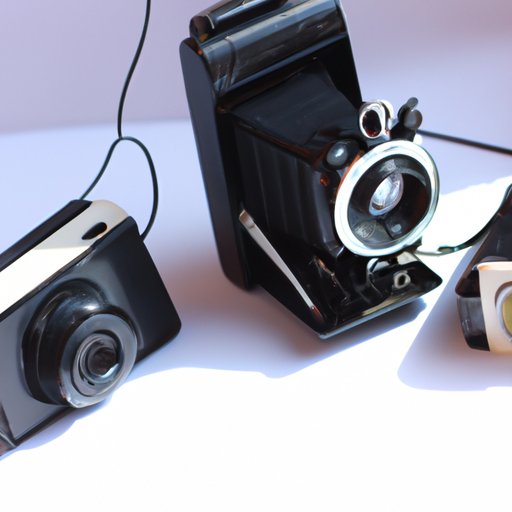Introduction
A camera is a device used to capture still or moving images. While cameras have become commonplace in our daily lives, it wasn’t always this way. In this article, we’ll take a look back at the invention of the camera, from its earliest models to the modern digital cameras of today. We’ll explore the impact of the camera on art and photography, as well as who invented the camera and when.

A Historical Look at the Invention of the Camera
The earliest known cameras date back to ancient Greece. These cameras were called camera obscuras, and they were essentially a dark room with a small hole in one wall. Light entering through the hole would cause an upside-down image to be projected onto the opposite wall. This same principle is still used in modern cameras.
The first photographs were taken by Joseph Nicephore Niepce in 1826. He used a camera obscura to capture the world’s first permanent photograph. In 1839, Louis Daguerre developed a new type of photography that used silver-coated copper plates. This process was called the daguerreotype, and it revolutionized photography.
In 1888, George Eastman created the first mass-marketed camera, the Kodak. The Kodak was a box camera that used roll film. This camera allowed anyone to take pictures without having to know how to develop their own film. This marked a major turning point in the history of photography.
How the Camera Changed the World
The invention of the camera changed the way people saw the world. Before the invention of the camera, paintings were the only way to capture images of people and places. With the invention of the camera, art could now be captured in a fraction of the time it took to paint.
The invention of the camera also had a major impact on communication. For the first time, people could send images to each other quickly and easily. This made it possible for news and information to be shared more quickly than ever before. The invention of the camera also enabled people to document their lives in ways that had never been possible before.

Exploring the Impact of the Camera on Art and Photography
The invention of the camera revolutionized the arts. Painters no longer had to rely solely on their own skills to create art. They could now use photography to capture images and then use those images as inspiration for their work. This led to a new form of art known as “photo-realism” where painters would recreate photographs in a realistic style.
The invention of the camera also popularized photography. Before the invention of the camera, photography was a tedious and expensive process that required a great deal of skill. With the invention of the camera, anyone could take pictures with relative ease. This led to a surge in the popularity of photography, which continues to this day.
The Inventors Behind the Camera: Who Developed it and When?
The invention of the camera can be attributed to several different inventors. Joseph Nicephore Niepce is credited with taking the first photograph in 1826. Louis Daguerre developed the daguerreotype in 1839, which revolutionized photography. Finally, George Eastman created the first mass-marketed camera in 1888.

A Timeline of Camera Technology: From Its Early Invention to Present Day
1826-1860: The daguerreotype was introduced, which revolutionized photography. This process used silver-coated copper plates to capture images.
1861-1888: Roll film and the Kodak camera were invented. This allowed anyone to take pictures without having to know how to develop their own film.
1889-1925: Box cameras became popular. These cameras used simple lenses and shutters to take pictures.
1926-1960: The first single-lens reflex (SLR) cameras were developed. These cameras used mirrors and prisms to allow photographers to see exactly what the camera would capture.
1961-Present: Digital photography revolutionized the industry. Digital cameras allowed for better image quality and faster processing times.
Conclusion
The invention of the camera changed the way people saw the world. From its earliest models to the modern digital cameras of today, the camera has revolutionized art and photography, as well as communication. It has enabled us to capture images and memories in ways that were never before possible. The invention of the camera was a major milestone in the history of technology, and its impact can still be felt today.
(Note: Is this article not meeting your expectations? Do you have knowledge or insights to share? Unlock new opportunities and expand your reach by joining our authors team. Click Registration to join us and share your expertise with our readers.)
